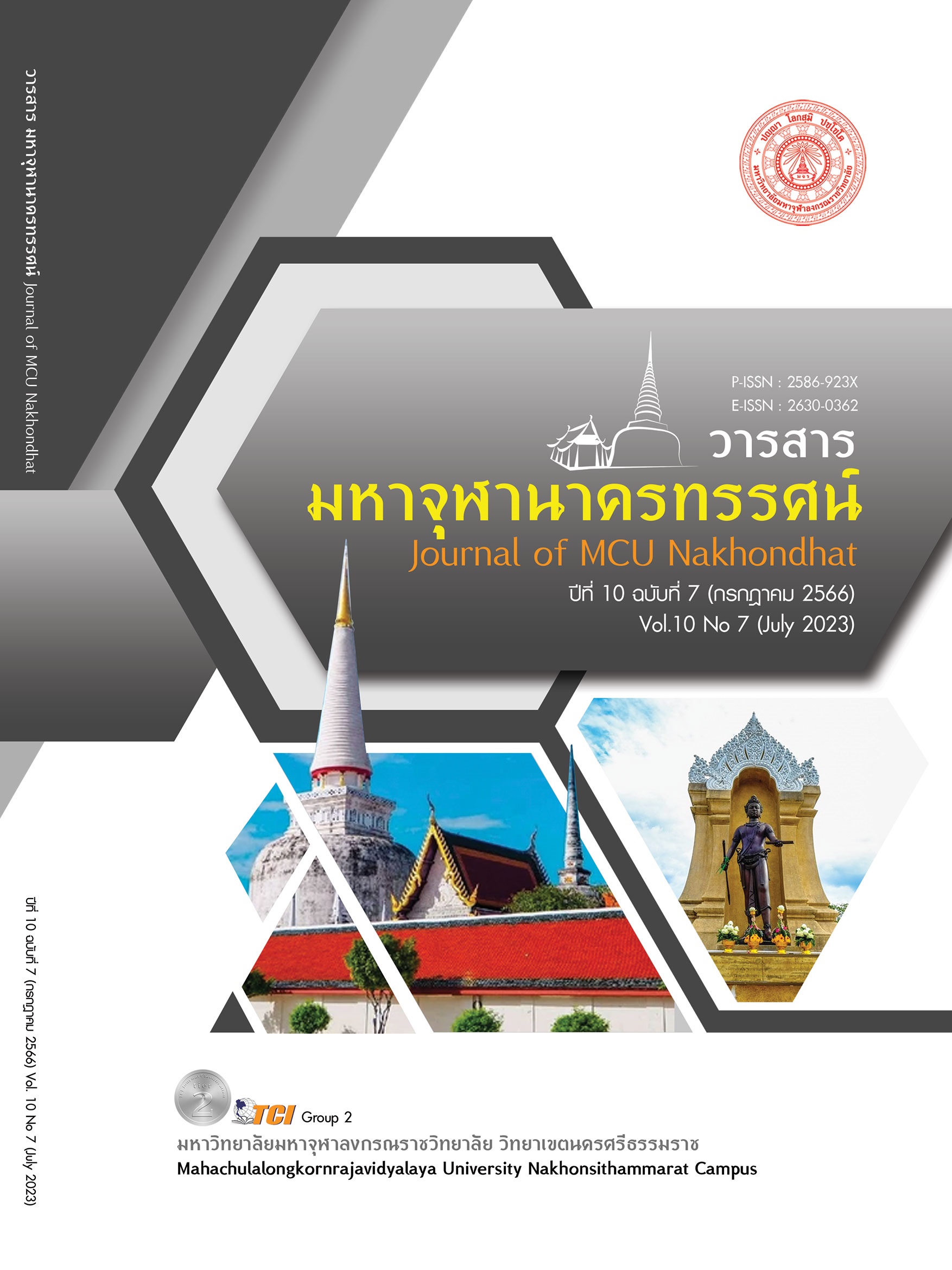การพัฒนากิจกรรมการเรียนรู้โดยใช้แบบจำลองเป็นฐาน เรื่อง ระบบภูมิคุ้มกัน เพื่อส่งเสริมความสามารถในการคิดเชิงระบบ สำหรับนักเรียนชั้นมัธยมศึกษาปีที่ 5
Main Article Content
บทคัดย่อ
บทความวิจัยนี้มีวัตถุประสงค์ คือ 1) สร้างและประเมินระสิทธิภาพกิจกรรมการเรียนรู้โดยใช้แบบจำลองเป็นฐาน เรื่อง ระบบภูมิคุ้มกัน ให้มีประสิทธิภาพตามเกณฑ์ 75/75 2) เปรียบเทียบความสามารถในการคิดเชิงระบบระหว่างก่อนและหลังเรียนด้วยกิจกรรมการเรียนรู้โดยใช้แบบจำลองเป็นฐาน เรื่อง ระบบภูมิคุ้มกัน 3) ศึกษาความพึงพอใจของนักเรียนที่มีต่อการเรียนด้วยกิจกรรมการเรียนรู้โดยใช้แบบจำลองเป็นฐาน เรื่อง ระบบภูมิคุ้มกัน ผู้วิจัยดำเนินการวิจัยตามกระบวนการวิจัยและพัฒนา กลุ่มตัวอย่างเป็นนักเรียนชั้นมัธยมศึกษาปีที่ 5 ภาคเรียนที่ 2 ปีการศึกษา 2565 โรงเรียนบางกระทุ่มพิทยาคม อยู่ในสังกัดสำนักงานเขตพื้นที่การศึกษาพิษณุโลก อุตรดิตถ์ จำนวน 40 คน ได้จากวิธีการสุ่มอย่างง่าย เครื่องมือที่ใช้ในการวิจัย คือ 1) กิจกรรมการเรียนรู้โดยใช้แบบจำลองเป็นฐาน เรื่อง ระบบภูมิคุ้มกัน 2) แบบวัดความสามารถในการคิดเชิงระบบ 3) แบบประเมินความพึงพอใจต่อกิจกรรมการเรียนรู้โดยใช้แบบจำลองเป็นฐาน เรื่อง ระบบภูมิคุ้มกัน สถิติที่ใช้วิเคราะห์ข้อมูล คือ ร้อยละ ค่าเฉลี่ย ส่วนเบี่ยงเบนมาตรฐาน ค่าประสิทธิภาพ E1/E2 และการทดสอบ t-test ผลการวิจัยพบว่า 1) กิจกรรมการเรียนรู้โดยใช้แบบจำลองเป็นฐาน เรื่อง ระบบภูมิคุ้มกัน มีผลการประเมินความเหมาะสมอยู่ที่ระดับมากที่สุด ( = 4.50, S.D.= 0.51) และมีประสิทธิภาพ 75.23/75.31 ซึ่งมีประสิทธิภาพเป็นไปตามเกณฑ์ 75/75 2) ความสามารถในการคิดเชิงระบบของนักเรียน หลังเรียนด้วยกิจกรรมการเรียนรู้โดยใช้แบบจำลองเป็นฐาน เรื่อง ระบบภูมิคุ้มกัน สูงกว่าก่อนเรียนอย่างมีนัยสำคัญทางสถิติที่ระดับ .05 3) ความพึงพอใจของนักเรียนต่อกิจกรรมการเรียนรู้โดยใช้แบบจำลองเป็นฐาน เรื่อง ระบบภูมิคุ้มกัน อยู่ในระดับมาก ( = 4.33, S.D.= 0.69)
Article Details

อนุญาตภายใต้เงื่อนไข Creative Commons Attribution-NonCommercial-NoDerivatives 4.0 International License.
เอกสารอ้างอิง
โกวิท ประวาลพฤกษ์. (2527). การประเมินในชั้นเรียน. กรุงเทพมหานคร: ไทยวัฒนาพานิช.
กระทรวงศึกษาธิการ. (2560). ตัวชี้วัดและสาระการเรียนรู้แกนกลาง กลุ่มสาระการเรียนรู้วิทยาศาสตร์ (ฉบับปรับปรุง พ.ศ.2560) ตามหลักสูตรแกนกลางการศึกษาขั้นพื้นฐาน พุทธศักราช 2551. กรุงเทพมหานคร: โรงพิมพ์ชุมนุมสหกรณ์การเกษตรแห่งประเทศไทย.
ชนาธิป โหตรภวานนท์ และคณะ. (2562). การพัฒนาการคิดอย่างเป็นระบบสำหรับนักเรียนชั้นมัธยมศึกษาปีที่ 4 เรื่อง ระบบประสาทและอวัยวะรับความรู้สึก โดยใช้การจัดการเรียนรู้แบบจำลองเป็นฐาน. วารสารศึกษาศาสตร์ มหาวิทยาลัยนเรศวร, 21(2), 64-78.
ชัยวัฒน์ ถิระพันธุ์ และคณะ. (2551). วิธีคิดกระบวนระบบ. กรุงเทพมหานคร: ศูนย์คุณธรรม.
ชาตรี ฝ่ายคำตา และภรทิพย์ สุภัทรชัยวงศ์. (2557). การจัดการเรียนรู้โดยใช้แบบจำลองเป็นฐาน Model-Based Learning. วารสารศึกษาศาสตร์ ปริทัศน์, 29(3), 86-99.
บุญชม ศรีสะอาด. (2556). การวิจัยเบื้องต้น. (พิมพ์ครั้งที่ 9). กรุงเทพมหานคร: สุวีริยาสาส์น.
ปารมี ศรีบุญทิพย์ และคณะ. (2560). การวิเคราะห์องค์ประกอบเชิงยืนยันของการคิดเชิงระบบของนักเรียนชั้นมัธยมศึกษาปีที่ 1 โรงเรียนสาธิตมหาวิทยาลัยของรัฐ สังกัดสำนักงานคณะกรรมการการอุดมศึกษา. Veridian E-Journal, Silpakorn University, 10(3), 38-51.
ภรทิพย์ สุภัทรชัยวงศ์ และคณะ. (2558). การจัดการเรียนรู้โดยใช้แบบจำลองเป็นฐานเพื่อพัฒนาแบบจำลองทางความคิด เรื่อง โครงสร้างอะตอมและความเข้าใจธรรมชาติของแบบจำลองของนักเรียนชั้นมัธยมศึกษาปีที่ 4. วารสารนวัตกรรมการเรียนรู้, 1(1), 97-124.
รัตนะ บัวสนธ์. (2562). การวิจัยและพัฒนานวัตกรรมการศึกษา. (พิมพ์ครั้งที่ 2). กรุงเทพมหานคร: จุฬาลงกรณ์มหาวิทยาลัย.
ฤทัยรัตน์ ชิดมงคล และสมยศ ชิดมงคล. (2560). การคิดเชิงระบบ: ประสบการณ์สื่อการสอนเพื่อพัฒนาการคิดเชิงระบบ. วารสารครุศาสตร์, 45(2), 209-224.
วิจารณ์ พานิช. (2558). การเรียนรู้สู่การเปลี่ยนแปลง Transformative Learning. กรุงเทพมหานคร: มูลนิธิสยามกัมมาจล.
สถาบันส่งเสริมการสอนวิทยาศาสตร์และเทคโนโลยี. (2562). หนังสือเรียนรายวิชาเพิ่มเติ่มวิทยาศาสตร์และเทคโนโลยีชีววิทยา ชั้นมัธยมศึกษาปีที่ 5 เล่ม 4. (พิมพ์ครั้งที่ 2). กรุงเทพมหานคร: สำนักพิมพ์แห่งจุฬาลงกรณ์มหาวิทยาลัย.
สำนักงานเลขาธิการสภาการศึกษา. (2559). การวิเคราะห์ปัจจัยเชิงสาเหตุเพื่อพัฒนาสมรรถนะกำลังคนรองรับโลกศตวรรษที่ 21 (ฉบับสรุป). กรุงเทพมหานคร: สำนักงานเลขาธิการการศึกษา.
สำนักวิชาการและมาตรฐานการศึกษา. (2553). แนวทางการพัฒนาการวัดและประเมินคุณลักษณะอันพึงประสงค์ตามหลักสูตรแกนกลางการศึกษาขั้นพื้นฐานพุทธศักราช 2551. กรุงเทพมหานคร: สำนักงานคณะกรรมการการศึกษาแห่งชาติ.
อารี พันธ์มณี. (2557). ฝึกให้คิดเป็น คิดให้สร้างสรรค์. กรุงเทพมหานคร: จุฬาลงกรณ์มหาวิทยาลัย.
ฮามีด๊ะ มูสอ. (2555). การพัฒนาแบบจำลองทางความคิดเรื่อง กรด-เบส ของนักเรียนชั้นมัธยมศึกษาปีที่ 5 ด้วยกิจกรรมการเรียนรู้โดยใช้แบบจำลองเป็นฐาน. ใน วิทยานิพนธ์ศึกษาศาสตร์มหาบัณฑิต สาขาวิทยาศาสตร์ศึกษา. มหาวิทยาลัยเกษตรศาสตร์.
Bryce, C. M. et al. (2016). Exploring Models in the Biology Classroom. The American Biology Teacher, 78(1), 35-42.
Buckley, B. C. et al. (2004). Model-Based Teaching and Learning with BioLogicalTM: What Do They Learn? How Do They Learn? How Do We Know? Journal of Science Education and Technology, 13(1), 23-41.
Kenyon, L. et al. (2008). The Benefits of Scientific Modeling. Science and Children, 46(2), 41-44.


